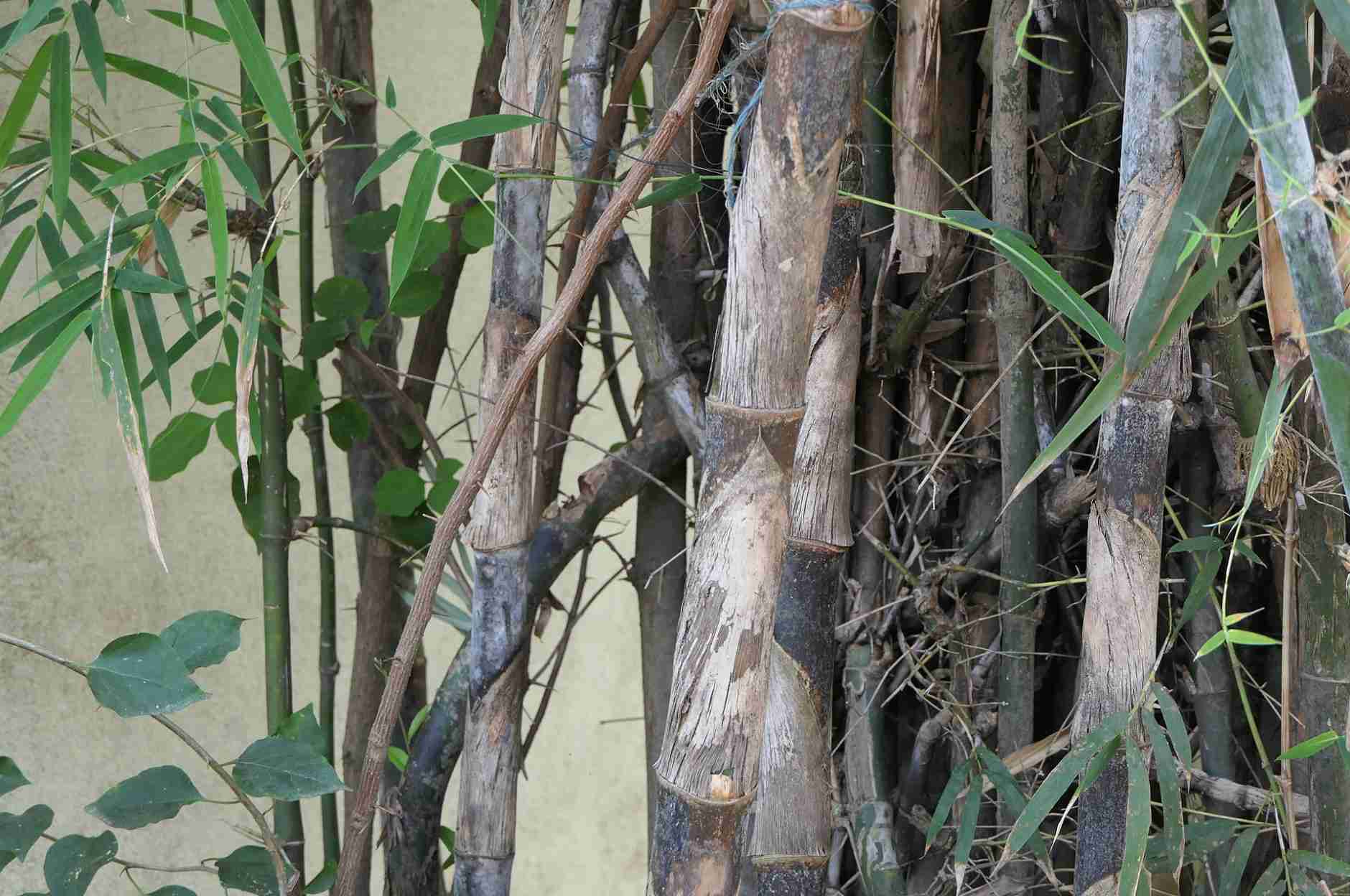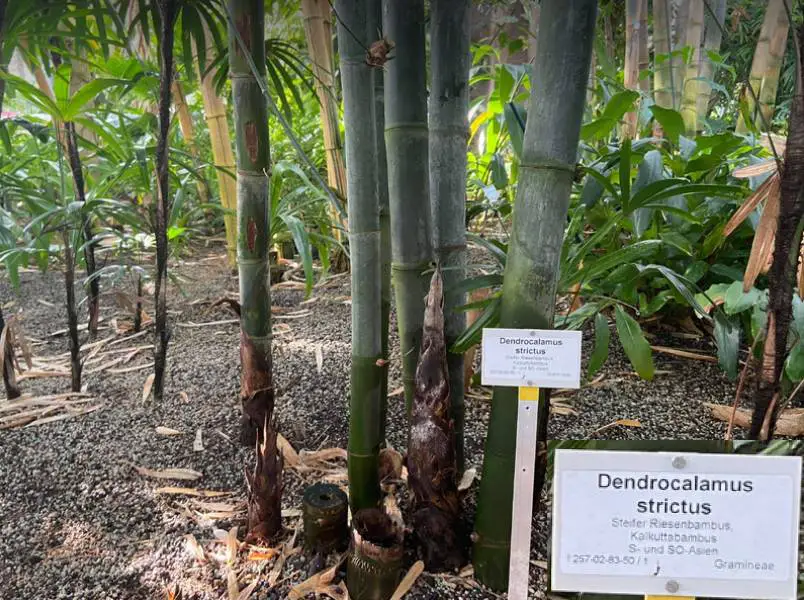As a bamboo lover, habitual traveler, and digital nomad, there are few things I enjoy more than a long journey to an exotic bamboo grove. Travel restrictions related to COVID made these excursions pretty difficult for a while, but not impossible. In 2022 I had the pleasure of visiting Berlin, Germany. Although it’s one of the least likely places to go in search of bamboo, I did stumble across a wide variety of species at Berlin’s Botanical Garden. I even spotted a rare and remarkable specimen of Dendrocalamus strictus, one of my favorite species of giant bamboo, in the tropical greenhouse. And more recently, I identified several clumps of Iron Bamboo growing in Mozambique.
Dendrocalamus strictus is a species of giant, tropical bamboo native to the tropics of Northeast India and Southeast Asia. It also grows in Malaysia, Indonesia, and the Philippines. In India, it has earned the nickname Calcutta Bamboo. In other places, they call it Male Bamboo or Solid Bamboo. And in parts of Indonesia, it goes by the local Malay moniker Bambu Batu, which can also translate as Iron Bamboo. This unusually strong variety of timber bamboo has many industrial applications, for construction and paper-making. But it’s rarely found outside the tropical and subtropical climes of Southern Asia.
This article is part of an ongoing series about different species of bamboo. To learn more about this fascinating subfamily of grasses, check out some of these other articles.
- Black bamboo
- Golden bamboo
- Bambusa oldhamii: Chinese timber bamboo
- Chimonobambusa quadrangularis: Square bamboo
- Dendrocalamus asper: Giant bamboo
- Pseudosasa japonica: Arrow bamboo
- Semiarundinaria fastuosa: Temple bamboo
Characteristics of Dendrocalamus strictus
The genus name Dendrocalamus literally translates to something along the lines of “tree-like culm”. But we can read it more eloquently as “timber bamboo”. Like all members of this genus, D. strictus is a giant bamboo, commonly reaching 50 or 60 feet in height, with culms between one and three inches thick. But it still pales in comparison to some of its more massive cousins, such as D. asper, D. giganteus, or D. sinicus, which often exceed 100 feet.
As a tropical bamboo genus, all species of Dendrocalamus have a clumping growth habit. Rather than spreading the way a running bamboo will, these bamboos remain relatively contained, in a dense clump or thicket. The species name, strictus, means strict or tight, and may refer to the tight, compact nature of its clumps. Or it might have something to do with this bamboo’s stiffness and lack of flexibility, which is related to the poles sometimes being solid rather than hollow.
Distribution and climate
Dendrocalamus strictus is native to Northeast India, and especially the region around the Ganges River. This habitat also includes Bangladesh and Myanmar, as well as parts of Nepal and Thailand. Today the species has spread further out and is now cultivated throughout Southeast Asia, Malaysia, Indonesia, and the Philippines.
It’s obvious from its distribution that D. strictus prefers a tropical or subtropical climate. But it actually does better with less relative humidity. In moist conditions, the culms of this bamboo are hollow, like most bamboo. In drier conditions, however, the culms walls grow very thick, even to the point of being solid.
This species can tolerate weather down to a few degrees below freezing, but it will grow more vigorously in a warm climate. They can withstand high temperatures well over 100º F.
Cultivating Dendrocalamus strictus
In the United States, a tropical bamboo like this will only thrive in places like Southern California, Florida, or the Deep South. Even so, it’s not particularly popular as an ornamental variety. The prolific branches on this species can make for a pretty thick and uninviting grove. However, as we see in the photo at the top of the article, the groundkeepers at the Berlin Botanical Gardens are able to keep their clump looking well-pruned and attractive.
Uses for Dendrocalamus strictus
In Southeast Asia, this species is widely used for building, light construction, and a variety of crafts. The fact that it sometimes grows with solid culms makes the particular bamboo unusually strong and resistant to cracking. Like Tonkin Bamboo, the thinner canes of this species are very suitable as fishing poles and ski poles. It’s also one of the most important bamboo varieties for paper-making.
If you’re interested in acquiring some Dendrocalamus strictus canes for yourself, or for any kind of smaller bamboo projects, you can contact Calcutta Bamboo in India. They ship their high-quality bamboo poles all over the world.

Naming of Dendrocalamus strictus
To be honest, the number one reason I love this species of bamboo is for its name. And I’m not talking about the botanical name, Dendrocalamus strictus, which rolls off the tongue like a barrel of wood chips. I’m referring to the plant’s Indonesian nickname, from the Malay language, Bambu Batu.
Calcutta Bamboo
Calcutta Bamboo is perhaps the most common name for Dendrocalamus strictus, making reference to Northeast India, where the species is most prevalent. It is native to this area around the Ganges River, including Bangladesh as well as Myanmar and Nepal. When this species of bamboo gets shipped around the world, its voyage almost always begins at the harbor of Calcutta.
Bambu Batu
In Malaysia and Indonesia they call it Bambu Batu. And if you can utter those four syllables without cracking a smile, then you must have a heart of stone. But seriously, we liked the name so much that we used it for the name of our business, Bambu Batu: The House of Bamboo. And speaking of stone, to answer a frequently asked question, the word Batu actually means stone or rock.
In English, this species of bamboo also has a number of common, non-scientific names. None of them equates to the direct translation of Bambu Batu, which would be Bamboo Stone, but some of them do allude to this grass’s superior strength or hardness. A more apt translation for Bambu Batu is Iron Bamboo.

Iron Bamboo, Giant Bamboo, Male Bamboo
One of several bamboo species to earn the nickname Giant Bamboo, Dendrocalamus strictus belongs to an elite club of massive grasses. It is one of the bulkiest varieties of bamboo, but the name Giant Bamboo is used widely and can refer to a wide array of timber bamboo species.
The common appellation of Iron Bamboo is the closest we get to Bambu Batu, or Stone Bamboo. But like many common names, this epithet is not unique to D. strictus. Numerous species of giant, construction-quality bamboo go by that name. And there’s a rare genus of Chinese bamboo called Ferrocalamus, or Iron Bamboo, which includes three different species.
This giant grass is also sometimes called Solid Bamboo. As mentioned above, when D. strictus grows in areas with less relative humidity, its culms have a tendency to grow thicker, nearly to the point of being solid inside, rather than hollow. Again, it’s not the only species known as Solid Bamboo.
Male Bamboo is yet another nickname for D. strictus, and it seems to refer exclusively to this species. But it’s unclear why they call it Male Bamboo, as this grass doesn’t have genders. Interestingly, Bambusa balcooa, another tropical timber bamboo from Northeast India, commonly goes by the name Female Bamboo.
Steifer Riesenbambus
If you look closely at the sign on the featured image at the top of the article, you can read the binomial nomenclature as well as a couple of common names in German. (I took the photo at the Botanical Gardens in Berlin.)
The first name says Steifer Reisenbambus, which translates to something like Stiff Giant Bamboo. The Germans, somewhat famous for their precision of language, managed to convey the plant’s strength, size, and rigidity with this eloquent title.
Below that, the sign also mentions the name Kalkuttabambus, or Calcutta Bamboo.
Is ‘Tam Vong’ the same as Dendrocalamus strictus?
In Vietnam, there is an extremely important species of bamboo they call ‘Tam Vong”. The poles, only about 2 inches in diameter, are solid, or nearly solid, with exceptional strength. This variety of bamboo is ideal for furniture and other light construction.

Although we still don’t have a definitive consensus, some authors identify ‘Tam Vong’ as Dendrocalamus strictus. We have reason to believe that it’s actually a sub-strain of the original species, similar to Black bamboo and Henon, which are both varieties of Phyllostachys nigra. Others identify Tam Vong with Monastery Bamboo, Thyrsostachys siamensis.
A similar challenge exists with the variety known as ‘Tre Gai’. Many specialists recognize it as Bambusa blumeana, but there’s still some debate around that as well.
Additional Reading
If you’re a bamboo enthusiast like me, and you can never get enough of the botanical minutiae, you might also enjoy some of these other informative articles.
- Bamboo Basics: Runners vs Clumpers
- Bamboo Taxonomy: Classes and tribes
- The etymology of rhizomes: Running the risk
- Bamboo Anatomy: 9 parts of the bamboo plant
- 12 Common questions about bamboo
FEATURE PHOTO: Dendrocalamus strictus in the tropical greenhouse of the Berlin Botanical Gardens. (Photo by Fred Hornaday.)
NOTE: This article first appeared in November 2021, most recently updated in November 2023.





















I loved the article Fred! It’s quite interesting that one species can have so many names and nicknames. Thanks for sorting them out!
My pleasure!
This specie is called Manvel in peninsular india and is commonly used in agriculture as support poles for tomato, brinjal and gourd crops. Apart from this, it is used everywhere from heavy construction to cane work.
In the dry weather of Maharashtra, Telangana and Karnataka region, it grows so strong and thick, that splitters, blades , shears and even power saw blades surrender pretty fast on them.
We do share your love for Manvel.
Thank you, Kiran. Indeed, that’s why they sometimes call it Iron Bamboo. But I wasn’t aware of this other name, Manvel.